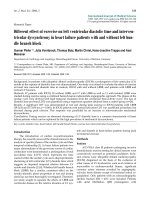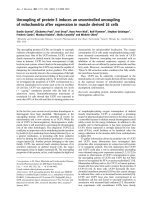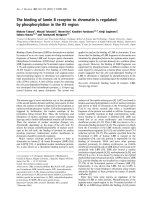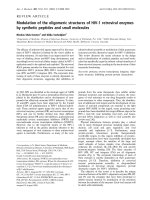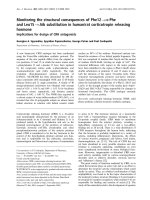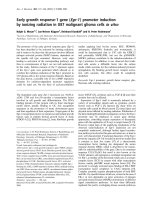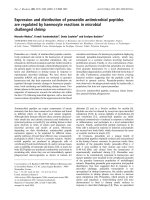Báo cáo y học: " HLA class II associations with rheumatic heart disease among clinically homogeneous patients in children in Latvia" pptx
Bạn đang xem bản rút gọn của tài liệu. Xem và tải ngay bản đầy đủ của tài liệu tại đây (70.74 KB, 7 trang )
R340
Introduction
According to data from the Latvian Rheumatic Disease
Patient Registry, 1298 children (born between 1984 and
2002) suffer from rheumatic diseases, of which rheumatic
fever (RF) is the third most frequent. RF is an autoimmune
connective tissue disease that develops after group A
beta haemolytic streptococcal infection. The typical
feature of the disease is the formation of autoantibodies
against the connective tissue structures in the heart, syn-
ovial tissue, and neurons in the central nervous system.
Rheumatic heart disease (RHD) is one of the most severe
consequences of RF and is the main cause of acquired
valvular RHD in the world [1–9]. In Latvia, since 1991 the
number of RF cases in children under the age of 18 has
increased, reaching an incidence of 7.5/100,000 in 1998.
From 1999 to 2002, the incidence was stable, at
2.1/100,000 children.
Several authors have documented the familial occurrence
of the disease [10–12], and it has been concluded that
susceptibility to RF is inherited as a single recessive gene
[13]. More substantial evidence for a genetic association
was provided by Khanna and associates, who reported that
B-cell alloantigens, designated D8-17, were present in
99% of patients with RF [13]. Further support for the role
of genetic factors in susceptibility was provided by studies
on the associations of this disease with inheritance of the
HLA major histocompatibility antigens [14–23]. Several
studies have suggested that genetic susceptibility to RF
and RHD is linked to HLA class II alleles [20,24–34].
AVR = aortal valve regurgitation; MVL = multivalvular lesion; MVR = mitral valve regurgitation; OR = odds ratio; PCR–SSP = polymerase chain
reaction with amplification with sequence-specific primers; PCR = polymerase chain reaction; RF = rheumatic fever; RHD = rheumatic heart
disease.
Arthritis Research & Therapy Vol 5 No 6 Stanevicha et al.
Research article
HLA class II associations with rheumatic heart disease among
clinically homogeneous patients in children in Latvia
Valda Stanevicha
1
, Jelena Eglite
2
, Arturs Sochnevs
2
, Dace Gardovska
1
, Dace Zavadska
1
and
Ruta Shantere
3
1
Department of Pediatrics, Riga Stradinš University, Riga, Latvia
2
Department of Immunology, Riga Stradinš University, Riga, Latvia
3
Department of Rheumatology, Children’s Clinical University Hospital, Riga, Latvia
Corresponding author: Valda Stanevicha (e-mail: )
Received: 2 Jan 2003 Revisions requested: 3 Mar 2003 Revisions received: 11 Aug 2003 Accepted: 15 Aug 2003 Published: 8 Sep 2003
Arthritis Res Ther 2003, 5:R340-R346 (DOI 10.1186/ar1000)
© 2003 Stanevicha et al., licensee BioMed Central Ltd (Print ISSN 1478-6354; Online ISSN 1478-6362). This is an Open Access article: verbatim
copying and redistribution of this article are permitted in all media for any purpose, provided this notice is preserved along with the article's original
URL.
Abstract
Genetic control of immune reactions has a major role in the
development of rheumatic heart disease (RHD) and differs
between patients with rheumatic fever (RF). Some authors think
the risk of acquiring RHD is associated with the HLA class II DR
and DQ loci, but other views exist, due to the various HLA-typing
methods and ways of grouping cases. Our goal was to
determine the relations between HLA class II alleles and risk of or
protection from RF in patients with relatively homogeneous
clinical manifestations. A total of 70 RF patients under the age of
18 years were surveyed in Latvia. HLA genotyping of DRB1*01
to DRB1*18 and DQB1*0201-202, *0301-305, *0401-402,
*0501-504, and *0601-608 was performed using polymerase
chain reaction sequence-specific primers. Data for a control
group of 100 healthy individuals typed for HLA by the same
method were available from the databank of the Immunology
Institute of Latvia. Of the RF patients, 47 had RHD and 8 had
Sydenham’s chorea. We concluded that HLA class II DRB1*07-
DQB1*0401-2 and DRB1*07-DQB1*0302 could be the risk
alleles and HLA class II DRB1*06 and DQB1*0602-8, the
protective ones. Patients with mitral valve regurgitation more
often had DRB1*07 and DQB1*0401-2, and patients with
multivalvular lesions more often had DRB1*07 and DQB1*0302.
In Sydenham’s chorea patients, the DQB1*0401-2 allele was
more frequent. Genotyping control showed a high risk of RF and
RHD in patients with DRB1*01-DQB1*0301-DRB1*07-
DQB1*0302 and DRB1*15-DQB1*0302-DRB1*07-DQB1*0303.
Keywords: alleles, genetic, HLA class II, rheumatic fever, rheumatic heart disease
Open Access
Available online />R341
However, there has been an apparent discrepancy con-
cerning the nature of susceptibility or protective alleles
[27]. One explanation is that most investigations used
serological HLA genotyping methods that were less than
accurate, leading to false results and failure to discrimi-
nate between allele subgroups.
Genetic associations are more likely to be detected in clin-
ically homogeneous groups of patients, and therefore it is
important to separate carditis patients from patients
without carditis [27]. In studies in which RF patients with
carditis were analysed separately from those without
carditis, or in which only RHD patients mostly with mitral
valve disease were studied, the reported HLA associa-
tions were rather similar [20,25–28,34,35].
We analysed the case histories of all white children under
18 years of age living in Latvia who had been affected by
RF, with the aim to determine risk/protective alleles for RF
and RHD. The HLA class II alleles were determined using
polymerase chain reaction (PCR) in clinically homoge-
neous patient groups: RF patients with or without carditis
and in patients with a diagnosis of an RHD — mitral valve
regurgitation (MVR), mitral and aortal valve regurgitation or
multivalvular lesion (MVL), and aortal valve regurgitation
(AVR), and also cases of Sydenham’s chorea.
Materials and methods
Subjects
The study included 70 white children (48 boys [68.5%]
and 22 girls [31.4%]) in Latvia under the age of 18 (born
between 1984 and 2002) who had RF. Of these, 23
(32.8%) were less than 7 years old and 47 (67.1%) were
7 or older. The RF diagnosis was confirmed according to
Jones criteria. Eight RF patients had Sydenham’s chorea.
As a result of RF, 47 patients (67.1%) had developed
RHD. Cardiac valve damage was diagnosed by echocar-
diography and/or heart catheterisation. RHD patients were
further split into groups with MVR (n = 24; 34.3%), AVR
(n = 3; 4.3%), and MVR + AVR or MVL (n = 20; 28.6%).
Only 23 of the patients (32.8%) had fully recovered by the
age of 18. Recurrence of RF was recorded for 15% of the
patients because they had not received prolonged peni-
cillin treatment. Data for healthy individuals (n = 100) were
obtained from the Databank of the Immunology Institute of
Latvia. The control individuals were free of autoimmune
disease and had no family history of RF. In both groups
(RF patients and healthy individuals), HLA class II alleles
were determined by PCR.
DNA isolation
Genomic DNA was extracted from proteinase-K-treated
peripheral blood leukocytes using the routine salt-off
method. The DNA was stored in TE buffer (10 ml
Tris–HCl, pH 7.5, and 2 ml 0.5
M Na
2
EDTA per litre of dis-
tilled water). The DNA obtained was used immediately for
genotyping or was stored at –20°C. The DNA concentra-
tion, around 100–200 µg/ml, was determined by fluores-
cence with a DNA fluorimeter [36].
HLA-DR and -DQ genotyping by PCR
Low-resolution HLA-DR typing for DRB1* 01 to 18 and for
DQB1*0201-202, *0301-305, *0401-402, *0501-504,
and *0601-608 was performed by PCR with amplification
with sequence-specific primers (PCR–SSP) [37]. The reac-
tion mixture (15 µl) included 1µl DNA, 1.5µl PCR buffer
[50 m
M
KCl, 1.5 mM MgCl
2
, 10 mM
Tris-HCl, (pH 8.3)], 0.6 µl
dNTPs (25 mmol/l), 1.0µl specific primers (0.2 mmol/l), and
0.5 U of the Taq DNA polymerase (Promega). In addition,
the internal positive control primer pair C3 and C5 was
included in all reaction mixtures at a concentration one-fifth
that of the allele- and group-specific primers.
The reaction mixture was subjected to 35 amplification
cycles, each consisting of denaturation at 94°C (60 s), fol-
lowed by one cycle, annealing at 94°C (20 s), 67°C (2 s)
followed by seven cycles and extension at 93°C (5 s), 65°C
(4 s), with a final extension in step with 28 cycles. PCR
products were visualized by agarose-gel electrophoresis.
After addition of 2
M loading buffer, the PCR reaction mix-
tures were loaded in agarose gels prestained with ethidium
bromide (0.5 µk/ml gel). Gels were run for 15 min at
10 V/cm gel in 0.5 m
M
TBE (0.89 M Tris, 0.89 M Boric acid
and 0.02
M EDTA in aqueous solution) buffer and then
examined under UV illumination and recorded [15,38–40].
Statistical
The HLA-DRB1 and DQB1 frequency of each allele and
genotype was compared between the patients and the
controls using the chi-square test. The P value and odds
ratio (OR) were calculated using EPI INFO software,
version 06, with 95% confidence intervals and Fisher
exact correction for small numbers [41].
Results
Frequencies of DRB1* and DQB1* alleles in RF patients
and control subjects
In RF patients, HLA class II DRB1*07 (OR = 4.18,
P < 0.01), DQB1*0302 (OR = 3.13, P < 0.0002), and
DQB1*0401-2 (OR = 4.33, P < 0.0001) alleles were
found more frequently than in the control group, while the
DRB1*06 (OR = 0.18, P < 0.0023), DQB1*0602-8
(OR = 0.4, P < 0.0127), and DQB1*0501 (OR = 0.26,
P < 0.0027) alleles were less frequent (Tables 1 and 2).
Frequencies of DRB1 and DQB1 alleles in RF, RHD, and
Sydenham’s chorea patients compared with control
subjects
In the homogeneous patient groups, DRB1*07 had the
highest OR in all RF groups (Table 3): patients with no
acquired valvular heart disease developing after RF carditis
(OR = 7.35, P < 0.001), MVR patients (OR=4.45,
Arthritis Research & Therapy Vol 5 No 6 Stanevicha et al.
R342
P < 0.03), MVL patients (OR=5.44, P < 0.01), and Syden-
ham’s chorea patients (OR = 11.31, P<0.002). The least
frequent allele was DRB1*06 (OR = 0.18, P<0.0023). The
DQB1 allele frequencies differed for RHD patients with
MVR and MVL: DQB1*0401-2 (OR = 8.20, P<0.001) was
more common in MVR patients and DQB1*0302
(OR = 4.18, P<0.001) in MVL patients (Table 3). In Syden-
ham’s chorea patients, a high frequency of DQB1*0401-2
(OR = 6.36, P<0.005) was found.
DRB1* and DQB1* genotypes associated with RF
patients
The strongest associations between DRB1* alleles and
RF patients were for DRB1*01-07 (OR = 8.57, P < 0.05),
DRB1*15-07 (OR = 2.86, P < 0.02), DRB1*04-05
(OR = 3.57, P < 0.04), and DRB1*05-07 (OR = 2.86,
P < 0.02) (Table 4). The DRB1*03-06 allele (OR = 0.48,
P < 0.01) had the lowest OR.
Common alleles associated with RF are: DQB1*0301-0302
(OR =5.44, P<0.05), DQB1*0302-0303 (OR = 4.43,
P<0.02), DQB1*0302-0601 (OR= 2.91, P < 0.01), and
DQB1*0302-0602-8 (OR = 2.19, P < 0.01) (Table 5). The
lowest allele frequencies in RF patients were observed for
DQB1*0201-2-0201-2 (OR = 0.28, P < 0.001) and
DQB1*0303-0602-8 (OR = 0.22, P < 0.01).
Discussion
HLA associations with RF and RHD have been frequently
investigated, but there is no unanimity of opinion about the
Table 1
Frequencies of DRB1* alleles in RF patients and healthy controls
DRB1* allele RF (n = 140) % Controls (n = 200) % Odds ratio P
*01 24 17 26 13 0.17 <0.643
*15 27 19 44 22 0.88 <0.3603
*03(*17;*18) 18 13 22 11 1.17 <0.184
*04 18 13 24 12 0.017 <0.305
*05(*11;*12) 30 21 33 16.5 1.3 <0.1288
*06(*13;*14) 4 3 28 14 0.18 <0.0023
*07 11 8 4 2 4.18 <0.01
*08 3 2 12 6 0.6** <0.403
*09 43211.81** <0.495
*10 1 0.7 5 2.5 0.28** <0.252
**Confield not accurate. Extract limits preferred. RF, rheumatic fever.
Table 2
Frequencies of DQB1* alleles in RF patients and healthy controls
DQB1* allele RF (n = 140) % Controls (n = 200) % Odds ratio P
*0201-2 17 12 32 16 0.76 <0.306
*0301 31 22 39 19.5 1.14 <0.29
*0302 25 18 13 6.5 3.13 <0.0002
*0303 7 5 13 6.5 0.77 <0.624
*0304 1 0.7 2 1 Undefined Undefined
*0305 1 0.7 – – Undefined Undefined
*0401-2 19 14 7 3.5 4.33 <0.0001
*0501 4 3 22 11 0.26** <0.0027
*0502-4 2 1 12 6 0.23** < 0.03
*0601 11 8 11 5.5 1.43 <0.053
*0602-8 22 16 49 24.5 0.4 <0.0127
**Confield not accurate. Extract limits preferred. RF, rheumatic fever.
association of specific alleles in connection with the
disease [20,32,33,35]. One reason for this discrepancy
might be the use of old HLA genotyping methods [27].
Besides the technical issues, it has also been suggested
that it is necessary to distinguish clinically homogeneous
patient groups, for example, patient groups with and
without rheumatic carditis, proved RHD, or Sydenham’s
chorea [27,33]. When patients have been divided into
clinically homogeneous patient groups, no differences
between ethnic groups have been found, with the
DRB1*0701, DRB1*0301, and DQB1*0201 alleles being
found at similar frequencies [18,21,32,42,43]. In medical
Available online />R343
Table 3
Frequencies of DRB1 and DQB1 alleles in RF and RHD patients compared with control subjects
Group (n = 140) DRB1*06 DRB1*07 DQB1*0302 DQB1*0401-2
All RF (n = 140) gf(P) + OR/χ
2
(0.0023) 0.18/11.96 (0.01) 4.18/6.68 (0.001) 3.13/10.67 (0.015) 4.33/11.79
MVR (n = 48) gf(P) + OR/χ
2
0.15 (0.03) 4.45/4.95 1.09 (0.001) 8.20/21.59
MVL (n = 40) gf(P) + OR/χ
2
0.18 (0.01) 5.44/6.59 (0.001) 4.18/10.21 1.25
Sydenham’s chorea gf(P) + OR/χ
2
0 (0.002)11.31/13.19 1.79 (0.005) 6.36/7.17
(n = 16)
without RHD (n = 46) gf(P) + OR/χ
2
0.31 (0.001) 7.35/11.65 (0.005) 3.50/7.81 (0.01) 4.14/6.78
Control subjects (n = 200) gf 0.14 0.02 0.07 0.04
Boldface type highlights statistically significant associations for patients vs controls. gf (gene frequency) P (probability), OR (odds ratio), and
Mantel–Hanszel values (χ
2
) are reported only for significant associations (P < 0.05). n = number of haplotypes (e.g. 140 haplotypes from 70
individuals). The nature of valve lesions was not reported for two patients. MVL, multivalvular lesions; MVR, mitral valve regurgitation; RF, rheumatic
fever; RHD, rheumatic heart disease.
Table 4
Significant association of HLA-DRB1 genotypes with predisposition/protection in RF patients
DRB1 RF (n = 70) % Controls (n = 100) % Odds ratio P (Fisher)
*01/*07 6 8.6 1 1 8.57 <0.05
*15/*03 6 8.6 2 2 4.29 <0.05
*15/*07 2 2.9 1 1 2.86 <0.02
*03/*06 1 1.4 3 3 0.48 <0.01
*04/*05 5 7.1 2 2 3.57 <0.04
*05/*07 2 2.9 1 1 2.86 <0.02
Boldface type highlights statistically significant associations for patients vs controls. RF, rheumatic fever.
Table 5
Significant association of HLA-DQB1 genotypes with predisposition/protection in RF patients
DQB1 RF (n = 70) % Controls (n = 100) % Odds ratio P (Fisher)
*0201-2/*0201-2 1 1.4 3 3 0.28 <0.001
*0201-2/*0602-8 4 5.7 8 8 0.71 <0.34
*0301/*0302 7 10 2 2 5.44 <0.05
*0302/*0303 3 4.3 1 1 4.43 <0.02
*0302/*0601 2 2.9 1 1 2.91 <0.01
*0302/*0602-8 3 4.3 2 2 2.19 <0.01
*0303/*0602-8 1 1.4 6 6 0.22 <0.01
Boldface type highlights statistically significant associations for patients vs controls. RF, rheumatic fever.
publications, there is no unanimity of opinion about
whether HLA class II alleles differ with the ethnic origin of
the patients, but this may be connected to the use of dif-
ferent methods of typing HLA alleles.
The data in our investigations were obtained by investigat-
ing RF and RHD patients classified into clinically homoge-
neous patient groups. We found that the HLA class II
DRB1*07, DQB1*0401-2, and DQB1*0302 alleles were
risk factors for acquiring RF and RHD. The DRB1*07
allele was common and had a comparatively high fre-
quency of incidence in patients with RF (Tables 1 and 3).
This suggests that DRB1*07 could be a risk allele for RF
and RHD. Our data on the high frequency of DRB1*07 in
white patients differs from data on Brazilian patients,
where HLA-DR7 was detected in the mulatto group of
patients [20,44]. In our study, the HLA II allele DRB1*07
was rather frequent in white RF patients, both with and
without permanent acquired valvular heart disease.
The HLA class II allele DQB1*0401-2 was found more
often in MVR patients, and DQB1*0302 in MVL patients.
Thus, it can be assumed that HLA-DQ genes control the
risk of development of RHD, both MVL and MVR. This
observation confirms previous findings for RHD patients in
Japan [32]. Our data obtained using the PCR–SSP
method suggests that a risk of developing RHD exists for
the carrier DQ allele exists in Brazil and Japan, as well as
in Latvia.
However, both the DQB1*0401-2 and *0302 allele fre-
quencies were significantly elevated in the RF patient
group and in patients who did not develop permanent
valvular heart disease.
The genotyping showed that a high risk of acquiring RF
and developing RHD was associated with DRB1*01-
DQB1*0301-DRB1*07-DQB1*0302 and DRB1*15-
DQB1*0302-DRB1*07-DQB1*0303. This, however, is
only a supposition, and further experiments with a larger
group will be necessary to establish whether it is correct.
Protective HLA class II alleles are as important as the risk
alleles. Alleles that can be designated protective include
DRB1*03-*06, DQB1*0201-2-*0201-2, and DQB1*0303-
*0602-8. Higher protection against RF and RHD is pro-
vided by the allele genotype DRB1*06-DQB1*0602-8
(Table 6).
Among the alleles found to be protective in our study,
DQB1*0602-8 is most often mentioned in the literature
[20,26,27,29]. Several risk/protective HLA class II sub-
alleles can be misperceived as other suballeles not con-
nected with RF and RHD. Therefore it is important to
determine genotypes [45–47].
HLA alleles regulate the immune response to infections
[48,49], binding and presenting autoantigens with different
affinities and regulating selection of T cells, and at the same
time they themselves can serve as target autoantigens
[50–52]. Different autoimmune peptide presentations with
protective or risk alleles are very important in the develop-
ment and research of the pathogenesis of autoimmunity.
The basis of autoimmune processes that contribute to the
development of RHD is T-cell molecular mimicry between
streptococcal and heart proteins. RHD is initiated by
certain serotypes connected with group A streptococcus
M protein. Guilherme and colleagues suggest that M5
peptide causes severe RHD in patients who have HLA-
DRB1*07 combined with severe RHD [53]. In our study,
patients with severe RF who developed RHD in cases of
MVR as well as MVL all had the DRB1*07 allele.
Conclusion
Our findings indicate that the HLA class II alleles DQB1*
and DRB1* are associated with a trend to risk/protection
relating to RF and the development of RHD. HLA class II
DRB1*07-DQB1*0401-2 and DRB1*07-DQB1*0302 can
be considered to be risk genotypes, while HLA class II
DRB1*06 and DQB1*0602-8 are probably protective.
Considering the association of the HLA-DRB1 and DQB1
genotype with RHD risk/protection, patients with
DRB1*07-DQB1*0401-2 are at risk of acquiring MVR, and
DRB1*07-DQB1*0302 patients are at risk of acquiring
MVL. By genotype analysis, we found that the RHD risk is
increased in individuals with DRB1*01-DQB1*0301-
DRB1*07-DQB1*0302 and DRB1*15-DQB1*0302-
DRB1*07-DQB1*0303 genotypes. As we mentioned
before, this conclusion is only a supposition, and study of a
larger group of patients would be required to confirm it.
Arthritis Research & Therapy Vol 5 No 6 Stanevicha et al.
R344
Table 6
Summary of HLA alleles or genotypes associated with
rheumatic heart disease
Allele associated with risk Allele associated with protection
DRB1*07 DRB1*06
DQB1*0401-2 DQB1*0602-8
DQB1*0302
DRB1*07-DQB1*0401-2 DRB1*06-DQB1*0602-8
DRB1*07-DQB1*0302
DRB1*01-DQB1*0301
DRB1*07-DQB1*0302
DRB1*15-DQB1*0302
DRB1*07-DQB1*0303
An asterisk preceding the allele number indicates the allele molecular
designation (typing at DNA level). Boldface type highlights association
cross-validated in this study.
The genotype DRB1*06-DQB1*0602-8 may be associ-
ated with protection against RF and the development of
RHD.
It is significant that the patients were grouped into clini-
cally homogeneous groups as opposed to the total RF
patient group, as the various subgroups differed in DQ
allele frequencies.
The severity of RF is probably associated with the
DRB1*07 allele and development of certain RHD may be
dependent on specific DQ alleles.
Our study provides further information about the hypothe-
sis that there is a genetic predisposition to RF and about
the protective immune responses in RHD. Further insight
into the molecular mechanisms of the disease will be a
useful tool for predicting the clinical outcome in RF
patients and may offer new means of and approaches to
treatment and prophylaxis design in the future.
Competing interests
None declared.
References
1. Markowitz M, Gerber MA: The Jones criteria for guidance in the
diagnosis of rheumatic fever: another perspective. Arch
Pediatr Adolesc Med 1995, 149:725-726.
2. Stollerman GH: Rheumatic fever. Lancet 1997, 349:935-942.
3. Shulman ST: Complications of streptococcal pharyngitis.
Pediatr Infect Dis J 1994, Suppl 1:S70-S74.
4. Kaplan E: Global assessment of rheumatic fever and
rheumatic heart disease at the close of the century: influ-
ences and dynamics of populations and pathogens: a failure
to realize prevention? Circulation 1993, 88:1964-1972.
5. Bisno AL: Group A streptococcal infections and acute
rheumatic fever. N Engl J Med 1991, 325:783-793.
6. Zabriskie JB, Gibofsky A: Genetic control of the suspectibility
to infection with pathogenic bacteria. Curr Top Microbiol
Immunol 1986, 124:1-20.
7. Ayoub EM: Acute rheumatic fever. In Heart Disease in Infants,
Children, and Adolescents. 5th edition. Edited by Emmanouilides
GC, Riemenschneider TA, Allen HD, Gutgesell HP. Baltimore,
MD: Williams & Wilkins; 1995:1400-1416.
8. Veasy LG, Hill HR: Immunologic and clinical correlations in
rheumatic fever and rheumatic heart disease. Pediatr Infect
Dis J 1997, 16:400-407.
9. Sanyal SK: Long-term sequelae of the first attack of accute
rheumatic fever during childhood. In Heart Disease in Infants,
Children, and Adolescents. 5th edition. Edited by Emmanouilides
GC, Riemenschneider TA, Allen HD, Gutgesell HP. Baltimore,
MD: Williams & Wilkins; 1995:1416-1440.
10. Read SE, Reid H, Poon-King T: HLAs and predisposition to the
nonsuppurative sequelae of group A streptococcal infections.
Transplant Proc 1977, 9:543-546.
11. Wilson MG, Schweitzer MD, Lubschez R: The familial epidemi-
ology of rheumatic fever: genetic and epidemiologic studies. J
Pediatr 1943, 22:468-492.
12. Wilson MG, Schweitzer M: Pattern of hereditary susceptibility
in rheumatic fever. Circulation 1954, 10:699-704.
13. Khanna AK, Buskirk DR, Williams RC Jr, Gibofsky A, Crow MK,
Menon A, Fotino M, Reid HM, Poon-King T, Rubinstein P, et al.:
Presence of a non-HLA B cell antigen in rheumatic fever
patients and their families as defined by a monoclonal anti-
body. J Clin Invest 1989, 83:1710-1716.
14. Ayoub EM, Barret DJ, Maclaren NK, Krischer JP: Association of
class II human histocompatibility leukocyte antigens with
rheumatic fever. J Clin Invest 1986, 77:2019-2026.
15. Anastasiou-Nana MI, Anderson JL, Carquist JF, Nanas JN:
HLA–DR typing and lymphocyte subset evaluation in
rheumatic heart disease: a search for immune response
factors. Am Heart J 1986, 112:992-997.
16. Jhinghan B, Mehra NK, Reddy KS, Taneja V, Vaidya MC, Bhatia
ML: HLA blood groups and secretor status in patients with
established rheumatic heart disease. Tissue Antigens 1986,
27:172-178.
17. Rajapakse CNA, Halim K, Al-Orainey I, Al-Nozha M, Al-Aska AK: A
genetic marker for rheumatic heart disease. Br Heart J 1987,
58:659-662.
18. Maharaj B, Hammond MG, Appadoo B. Leary WP, Phil D, Pudifin
DJ: HLA-A, B, DR and DQ antigens in black patients with
severe chronic rheumatic heart disease. Circulation 1987, 76:
259-261.
19. Taneja V, Mehra NK, Reddy S, Narula J, Tandon R, Vaidya MC,
Bhatia ML: HLA-DR/DQ antigens and reactivity to B cell
alloantigen D8/17 in Indian patients with rheumatic heart
disease. Circulation 1989, 80:335-340.
20. Guilherme L, Weidebach W, Kiss MH, Snitcowsky R, Khalil J:
Association of human leukocyte class II antigens with
rheumatic heart disease in Brazilian population. Circulation
1991, 83:1995-1998.
21. Ozkan M, Carin M, Sonmez G, Senocak M, Ozdemir M, Yakut C:
HLA antigens in Turkish race with rheumatic heart disease.
Circulation 1993, 87:1974-1978.
22. Weidebach W, Goldberg AC, Chiarella JM, Guilherme L, Snit-
cowsky R, Pileggi F, Khalil J: HLA class II antigens in rheumatic
fever: analysis of the DR locus by restriction fragment-length
polymorphism and oligotyping. Hum Immunol 1994, 40:253-258.
23. Ahmed S, Ayoub EM, Scornik JC, Wang CY, She JX: Post strep-
tococcal reactive arthritis: clinical characteristics and associa-
tion with HLA-DR alleles. Arthritis Rheum 1998, 41:1096-1102.
24. Cassidy JT, Petty RE: Textbook of Pediatric Rheumatology. 2nd
edition. Philadelphia: Churchill Livingstone; 1999.
25. DiSciascio G, Taranta A: Rheumatic fever in children. Am Heart
J 1980, 99:635-658.
26. Visentainer JE, Pereira FC, Dalalio MM, Tsuneto LT, Donadio PR,
Moliterno RA: Association of HLA-DR7 with rheumatic fever in
the Brazilian population. J Rheumatol 2000, 27:1518-1520.
27. Guedez Y, Kotby A, El-Demellawy M, Galal A, Thomson G, Zaher
S, Kassem S, Kotb M: HLA class II associations with rheumatic
heart disease are more evident and consistent among clini-
cally homogeneous patients. Circulation 1999, 99:2784-2790.
28. Maharaj B, Khedun SM, Hammond MG, van der Byl K: HLA-A, B,
DR, and DQ antigens in Indian patients with severe chronic
rheumatic heart disease. Jpn Heart J 1997, 38:663-668.
29. Bhat MS, Wani BA, Koul PA, Bisati SD, Khan MA, Shah SU: HLA
antigen pattern of Kashmiri patients with rheumatic heart
disease. Indian J Med Res 1997, 105:271-274.
30. Gu J, Yu B, Zhou J: HLA-DQA1 genes involved in genetic sus-
ceptibility to rheumatic fever and rheumatic heart disease in
southern Hans [in Chinese]. Zhonghua Nei Ke Za Zhi 1997, 36:
308-311.
31. Afanas’ev II, Kadyrova RT, Iazdovskii VV: [The HLA-associated
immunological mechanisms in rheumatic involvement of the
myocardium. — in Russian]. Terr Arkh 1995, 67:56-59.
32. Koyanagi T, Koga Y, Nishi H, Toshima H, Sasazuki T, Imaizumi T,
Kimura A: DNA typing of HLA class II genes in Japanese
patients with rheumatic heart disease. J Mol Cell Cardiol
1996, 28 :1349-1353.
33. Donadi EA, Smith AG, Louzada-Junior P, Voltarelli JC, Nepom GT:
HLA class I and class II profiles of patients presenting with
Sydenham’s chorea. J Neurol 2000, 247:122-128.
34. Olmez U, Turgay M, Ozenirler S, Tutkak H, Duzgun N, Duman M,
Tokgoz G: Association of HLA class I and class II antigens
with rheumatic fever in a Turkish population. Scand J Rheuma-
tol 1993, 22:49-52.
35. Carlquist JF, Ward RH, Meyer KJ, Husebye D, Feolo M, Anderson
JL: Immune response factors in Rheumatic heart disease:
meta-analysis of HLA-DR associations and evaluation of addi-
tional class II alleles. J Am Coll Cardiol 1995, 26:452-457.
36. Walsh PS, Metzger D, Higuchi R: Chelex 100 as a medium for
simple extraction of DNA for PCR-based typing from forensic
material. Biotechniques 1991, 10:506-513.
37. Alexseyev LP, Boldyreva MN, Trofimov D: Use of new variant
HLA-DNA typing -mSSP at perspective selection of the donor
Available online />R345
of a nephros. Proceedings of 2nd All-Russia scientific practical
conference. Polymerase chain reaction (PCR) at diagnostics and
the control of treatment contagious disease. Moscow. 1998:133-
134.
38. Olerup O, Zetterquist H: HLA-DR typing by PCR amplification
with sequence-specific primers (PCR-SSP) in 2 hours: An
alternative to serological DR typing in clinical practice includ-
ing donor-recipient matching in cadaveric transplantation.
Tissue Antigens 1992, 39:225-235.
39. Erlich H, Bugawan T, Begovich A, Scharf S, Griffith R, Saiki R,
Higuchi R, Walsh PS: HLA-DR, DQ and DT typing using PCR
amplification and immobilized probes. Eur J Immunogenet
1991, 18:33-35.
40. Walsh PS, Erlich H, Higuchi R: Preferential PCR amplification
of alleles: mechanisms and solutions. PCR Methods Appl
1992, 1:241-250.
41. Mehta CR, Patel NR, Gay RJ: Pascal program by ELF Franco & N
Compos-Filho Ludwig Cancer Institute: Mathematics Software
StatCalc. São Paulo, Brazil: Am. Stat. Assoc; 1985, 78:969-973.
42. Sirithunyanont Ch, Sura Th, Thamneum S, Busabarat M,
Yamwong S, Sritara P, Vejbaesya S, Tanomsup S, Boon-
baichaipruk S, Likitthanasombat K, Chandnanamatha P: Associa-
tion of human leukocyte antigens in Thais with rheumatic
heart disease. Intern Med J Thai 2001, 17:326-334.
43. Debaz H, Olivo A, Perez-Luque E, Vasquez-Garcia MN, Burguete
A, Chavez-Negrete A, Velasco C, Arguero R, Gorodeszky C: DNA
analysis of class II alleles in rheumatic disease in Mexicans
[abstract]. 22nd Annual ASHI Meeting Abstracts. Human
Immunology 1996, 49(suppl):63.
44. HLA Antigens in Brazilian Patients with Rheumatic Heart
Disease. [www.brazilpednews.org.br/].
45. Thorsby E: HLA associated diseases. A summary of the 12
th
International Histocompatibility workshop component. In HLA:
Genetic Diversity of HLA: Functional and Medical Implications.
Edited by Charron D. Paris, France: EDK; 1996:91-96.
46. Kotb M: Infection and autoimmunity: a story of the host, the
pathogen, and the copathogen. Clin Immunol Immunopathol
1995, 74:10-22.
47. Schmidt D, Verdager J, Nuzhat A, Santamaria P: A mechanism
for the major histocompatibility complex-linked resistance to
autoimmunity. J Exp Med 1997, 186:1059-1075.
48. Hill AVS: HLA and infection [review]. J R Coll Physicians Lond
1992, 26:11-16.
49. Ayoub EM, Kotb M, Cunningham MW: Rheumatic fever patho-
genesis. In Streptococcal Infections. Edited by Stevens DL,
Kaplan EL. New York, NY: Oxford University Press: in press.
50. Nepom GT: Class II antigens and disease suspectibility. Annu
Rev Med 1995, 46:17-25.
51. Sinha AA, Lopez MT, McDevit HO: Autoimune diseases: the
failure of self tolerance. Science 1990, 248:1380-1388.
52. McDevitt HO, Chinitz A: Genetic control of the antibody
response: relationship between immune responses and his-
tocompatibility (H-2) type. Science 1969; 163:1207-1208.
53. Guilherme L, Oshiro SE, Fae KC, Cunha-Neto E, Renesto G,
Goldberg AC, Tanaka AC, Pomerantzeff PM, Kiss MH, Silva C,
Guzman F, Patarroyo ME, Southwood S, Sette A, Kalil J: T-cell
reactivity against streptococcal antigens in the periphery
mirrors reactivity of heart-infiltrating T lymphocytes in
rheumatic heart disease patients. Infect Immun 2001, 69:
5345-5351.
Correspondence
Valda Stanevicha, Department of Pediatrics, Riga Stradinš University,
Sve
–
tes iela 6, R
I
–
gas rajons, Ma
–
rupe, LV 2167, Latvia. Tel: +371
9513988; fax: +317 7621730; e-mail:
Arthritis Research & Therapy Vol 5 No 6 Stanevicha et al.
R346

